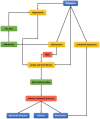Immunomodulatory Approaches in Diabetes-Induced Cardiorenal Syndromes
- PMID: 33585587
- PMCID: PMC7876252
- DOI: 10.3389/fcvm.2020.630917
Immunomodulatory Approaches in Diabetes-Induced Cardiorenal Syndromes
Abstract
Immunomodulatory approaches are defined as all interventions that modulate and curb the immune response of the host rather than targeting the disease itself with the aim of disease prevention or treatment. A better understanding of the immune system continues to offer innovative drug targets and methods for immunomodulatory interventions. Cardiorenal syndrome is a clinical condition that defines disorders of the heart and kidneys, both of which communicate with one another through multiple pathways in an interdependent relationship. Cardiorenal syndrome denotes the confluence of heart-kidney relationships across numerous interfaces. As such, a dysfunctional heart or kidney has the capacity to initiate disease in the other organ via common hemodynamic, neurohormonal, immunological, and/or biochemical feedback pathways. Understanding how immunomodulatory approaches are implemented in diabetes-induced cardiovascular and renal diseases is important for a promising regenerative medicine, which is the process of replacing cells, tissues or organs to establish normal function. In this article, after a brief introduction on the immunomodulatory approaches in diseases, we will be reviewing the epidemiology and classifications of cardiorenal syndrome. We will be emphasizing on the hemodynamic factors and non-hemodynamic factors linking the heart and the kidneys. In addition, we will be elaborating on the immunomodulatory pathways involved in diabetes-induced cardiorenal syndrome namely, RAS, JAK/STAT, and oxidative stress. Moreover, we will be addressing possible therapeutic approaches that target the former pathways in an attempt to modulate the immune system.
Keywords: JAK/STAT pathway; cardiorenal syndromes; diabetes mellitus; immunomodulatory approaches; oxidative stress; ras pathway.
Copyright © 2021 Ammar, Nahlawi, Shayya, Ghadieh, Azar, Harb and Eid.
Conflict of interest statement
The authors declare that the research was conducted in the absence of any commercial or financial relationships that could be construed as a potential conflict of interest.
Figures




Similar articles
-
Cardiorenal Syndrome: Classification, Pathophysiology, Diagnosis, and Treatment Strategies: A Scientific Statement From the American Heart Association.Circulation. 2019 Apr 16;139(16):e840-e878. doi: 10.1161/CIR.0000000000000664. Circulation. 2019. PMID: 30852913
-
RAAS inhibition and cardiorenal syndrome.Curr Hypertens Rev. 2014;10(2):107-11. doi: 10.2174/1573402111666141231144228. Curr Hypertens Rev. 2014. PMID: 25549841 Review.
-
Cardiorenal Syndrome Revisited.Circulation. 2018 Aug 28;138(9):929-944. doi: 10.1161/CIRCULATIONAHA.117.028814. Circulation. 2018. PMID: 30354446 Review.
-
[PATHOPHYSIOLOGY OF THE CARDIORENAL SYNDROME].Acta Med Croatica. 2016 Dec;70(4-5):325-31. Acta Med Croatica. 2016. PMID: 29087629 Review. Croatian.
-
Beyond the Cardiorenal Syndrome: Pathophysiological Approaches and Biomarkers for Renal and Cardiac Crosstalk.Diagnostics (Basel). 2022 Mar 22;12(4):773. doi: 10.3390/diagnostics12040773. Diagnostics (Basel). 2022. PMID: 35453821 Free PMC article. Review.
References
Publication types
LinkOut - more resources
Full Text Sources
Other Literature Sources
Research Materials

